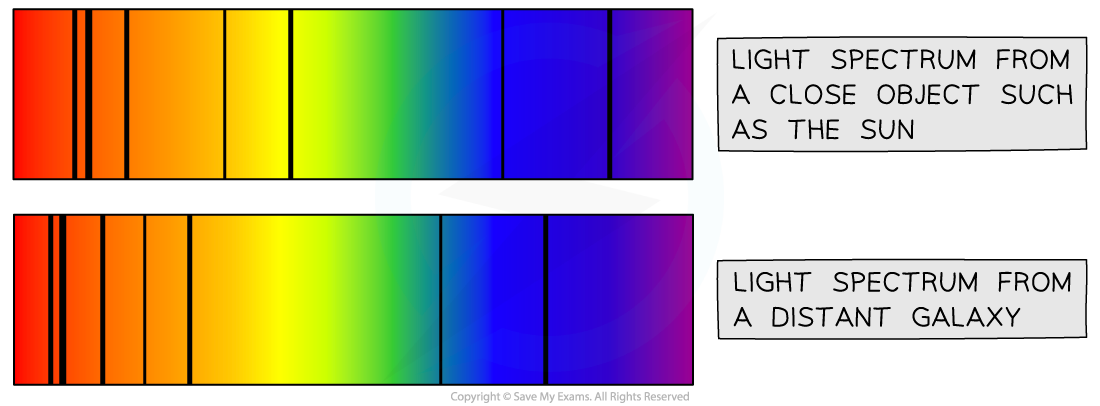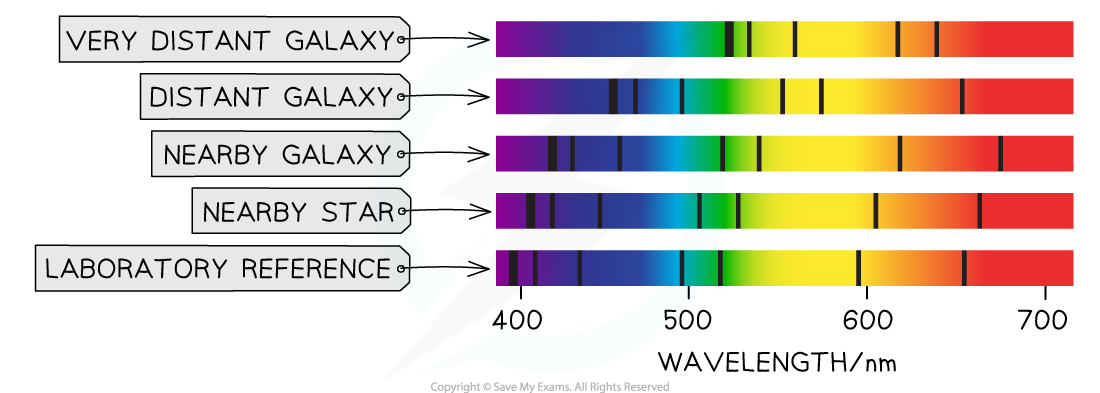Galactic Redshift (DP IB Physics) : Revision Note
Galactic Redshift
In space, the Doppler effect of light can be observed when spectra of distant stars and galaxies are observed, this is known as:
Redshift if the object is moving away from the Earth
The wavelength is increasing but the frequency is decreasing
Blueshift if the object is moving towards the Earth
The wavelength is decreasing but the frequency is increasing

Stars and galaxies can be red or blueshifted to an observer on Earth
Redshift is defined as:
The fractional increase in wavelength (or decrease in frequency) due to the source and observer receding from each other
Redshift can be observed by comparing the light spectrum produced from a close object, such as our Sun, with that of a distant galaxy
The light from the distant galaxy is shifted towards the red end of the spectrum (compared to the Sun's spectra)
This provides evidence that the universe is expanding

Comparing the light spectrum produced by the Sun with light from a distant galaxy
Positive and Negative Velocities
If the speed of the galaxy relative to Earth is positive then the galaxy is moving towards the Earth
This is the case when the observed frequency f0 is greater than the reference frequency f
If the speed of the galaxy relative to Earth is negative then the galaxy is moving away from the Earth
This is the case when the observed frequency f0 is less than the reference frequency f
An Expanding Universe
After the discovery of Doppler redshift, astronomers began to realize that almost all the galaxies in the universe are receding
This led to the idea that the space between the Earth and the galaxies must be expanding
This expansion stretches out the light waves as they travel through space, shifting them towards the red end of the spectrum

The expansion of the universe can be compared to dots on an inflating balloon
As the balloon is inflated, the dots all move away from each other
In the same way, as the rubber stretches when the balloon is inflated, space itself is stretching out between galaxies
Just like the dots, the galaxies move away from each other, however, they themselves do not move
Another observation from looking at the light spectra produced by distant galaxies is that the greater the distance to the galaxy, the greater the redshift
This means that the greater the degree of redshift, the faster the galaxy is moving away from Earth

The further a galaxy is from Earth, the greater its redshift tends to be

The furthest galaxies appear to be redshifted the most and are receding the fastest
Worked Example
The spectra below show dark absorption lines against a continuous visible spectrum.

A particle line in the spectrum of light from a source in the laboratory has a frequency of 4.570 × 1014 Hz. The same line in the spectrum of light from a distant galaxy has a frequency of 4.547 × 1014 Hz.
Calculate the speed of the distant galaxy in relation to the Earth. State whether it is moving towards or away from the Earth.
Answer:
Step 1: Write down the known quantities
Observed frequency, f0 = 4.547 × 1014 Hz
Reference (source) frequency, f = 4.570 × 1014 Hz
Shift in frequency, Δf = observed − source = (4.547 – 4.570) × 1014 = –2.3 × 1012 Hz
Speed of light, c = 3.0 × 108 m s–1
Step 2: Write down the Doppler redshift equation
Step 3: Rearrange for speed v, and calculate
= –1.5 × 106 m s–1
Step 4: Write a concluding sentence
The velocity is negative, so the source is moving away from the Earth
ORThe observed frequency is less than the source frequency, therefore, there is a decrease in frequency, so the source is receding, or moving away, from the Earth at 1.5 × 106 m s–1
Examiner Tips and Tricks
Keep travel of the minus signs in your calculation, as this gives you information about whether the object is moving away or towards the observer.
The speed of light is given in your data booklet, you will not need to memorise this value.

You've read 0 of your 5 free revision notes this week
Sign up now. It’s free!
Did this page help you?
